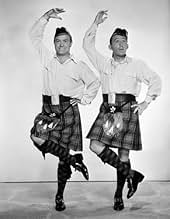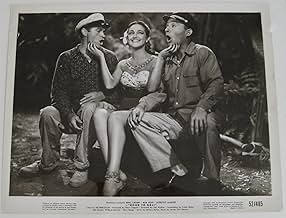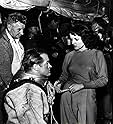VALUTAZIONE IMDb
6,4/10
5453
LA TUA VALUTAZIONE
Aggiungi una trama nella tua linguaTwo unemployed show-biz pals accept treasure-diving work in Bali for a local princess and they find treasure, love and trouble.Two unemployed show-biz pals accept treasure-diving work in Bali for a local princess and they find treasure, love and trouble.Two unemployed show-biz pals accept treasure-diving work in Bali for a local princess and they find treasure, love and trouble.
- Regia
- Sceneggiatura
- Star
Michael Ansara
- Guard
- (non citato nei titoli originali)
Besmark Auelua
- Lesser Priest
- (non citato nei titoli originali)
John Barton
- Audience Member
- (non citato nei titoli originali)
Phil Bloom
- Unemployed Man
- (non citato nei titoli originali)
Humphrey Bogart
- Charlie Allnut
- (filmato d'archivio)
- (non citato nei titoli originali)
Pat Borella
- Dancer
- (non citato nei titoli originali)
George Bruggeman
- Warrior
- (non citato nei titoli originali)
Robert Cabal
- Native
- (non citato nei titoli originali)
Steve Calvert
- Gorilla
- (non citato nei titoli originali)
Herman Cantor
- Priest
- (non citato nei titoli originali)
Sue Casey
- Handmaiden
- (non citato nei titoli originali)
Recensioni in evidenza
ROAD TO BALI (Paramount, 1952), directed by Hal Walker, reunites the famous trio of Bing Crosby, Bob Hope and Dorothy Lamour in another wild and crazy adventure for their sixth "Road" outing. Having traveled through "Singapore" (1940), "Zanzibar" (1941), "Morocco" (1942), "Utopia" (1945) and finally "Rio" (1947), with a lot of other territories to explore such as Borneo, Venice or even outer space, the writers came up with "Bali" as their next stop. With newfound surroundings, added Technicolor and surprise guest stars along the way, the material supplied, though hardly original, was no doubt quite popular in its day.
Opening with a commentary and visual over the map of Australia leading to the city in Melbourne, the story gets underway in a vaudeville house where American entertainers, George Cochran (Bing Crosby) and Harold Gridley (Bob Hope), longtime pals, are performing. Back stage are a couple of angry fathers with their daughters to whom these guys proposed, but each having no intention of marrying. Making their getaway, they soon end up on a train from which they jump out to avoid another angry father, ending up in a far away place surrounded by sheep. Arriving in another city as part of a cargo of sheep, the bearded George and Harold agree to accept jobs from Ken Ahok (Mervyn Vye) working as deep sea divers (with Harold doing the underwater job) to help locate buried treasure. Upon their arrival on an island paradise, the boys encounter Ahok's cousin, Lalah (Dorothy Lamour), a princess of Scottish descent. Because Ken Ahok happens to be responsible for the deaths of his previous divers, with intention of doing the same for these Americans, Lalah warns them that their mission means certain death. After Harold dives for and acquires the buried jewels, the trio break away from Ahok's murderous cutthroats and set sail out for Bali. While on the tropical island, further danger and numerous surprises awaits.
A movie being more fantasy than its intended South Seas island spoof, the film's best moments are its opening 20 minutes. In spite of every effort made turning out a great 91 minute comedy in the tradition of ROAD TO MOROCCO or ROAD TO UTOPIA, this latest "Road" installment grows tiresome long before it's all over. Crosby the con man, Hope the stooge, and Lamour the sarong girl in the middle, revive their past "Road" adventures with much familiarity, continue acting like over-age kids with their one "paddy cake" routine along with an assortment of ad-libs. In-jokes are put to the maximum this time around, some at a total loss for viewers today. Best bits however, are Hope and Crosby surrounded by beautiful maiden girls. An agonizing groan is heard off screen: Crosby: "What was that?" Hope: "It's Errol Flynn. He can't stand it." Or a clip insertion of Humphrey Bogart hauling The African Queen. (I thought Bali is in Indonesia!) Then there's Bing Crosby's brother Bob doing his bit with a "shot in the picture," along with Dean Martin and Jerry Lewis, as well as Jane Russell in some amusing bits. There's also a running gag throughout the film where the boys play a flute to see what slowly grows out of the basket. Murvyn Vye makes a fine villain, but it would have been nice having Anthony Quinn ("Singapore" and "Morocco") back for old times sake.
Musical interludes are a tradition in the series, with new score by Johnny Burke and James Van Heusen, including: "Chicago Style" (sung by Bing Crosby and Bob Hope); "Moonflowers" (sung by Dorothy Lamour); "Hoot-Mon" (sung by Hope and Crosby in kilts, performed by handmaidens and warriors); "To See You" (sung by Crosby); "The Merry-Go-Round Around" (sung by Bob Hope, Dorothy Lamour and Bing Crosby); "Moonflowers" (reprize by Lamour); and "Wedding Chant" (natives). For Crosby's solo, Hope faces the camera addressing the theater audience that it's time for them to step out and get some popcorn.
Having fallen to public domain, poor quality prints of ROAD TO BALI have turned up on home video and DVD over the years. Better prints available happen to come from cable channels American Movie Classics and Turner Classic Movies. Being a Paramount film, notice the TCM print with both Columbia and Paramount studio logos for its introduction.
ROAD TO BALI almost became the final "Road" adventure. Ten years later, an attempt was made to revive the formula, being THE ROAD TO HONG KONG (United Artists, 1962), starring Crosby and Hope with Lamour strangely reduced to cameo appearance. Overall, any movie that can make a "monkey" out of Bob Hope, can't be all bad. (***)
Opening with a commentary and visual over the map of Australia leading to the city in Melbourne, the story gets underway in a vaudeville house where American entertainers, George Cochran (Bing Crosby) and Harold Gridley (Bob Hope), longtime pals, are performing. Back stage are a couple of angry fathers with their daughters to whom these guys proposed, but each having no intention of marrying. Making their getaway, they soon end up on a train from which they jump out to avoid another angry father, ending up in a far away place surrounded by sheep. Arriving in another city as part of a cargo of sheep, the bearded George and Harold agree to accept jobs from Ken Ahok (Mervyn Vye) working as deep sea divers (with Harold doing the underwater job) to help locate buried treasure. Upon their arrival on an island paradise, the boys encounter Ahok's cousin, Lalah (Dorothy Lamour), a princess of Scottish descent. Because Ken Ahok happens to be responsible for the deaths of his previous divers, with intention of doing the same for these Americans, Lalah warns them that their mission means certain death. After Harold dives for and acquires the buried jewels, the trio break away from Ahok's murderous cutthroats and set sail out for Bali. While on the tropical island, further danger and numerous surprises awaits.
A movie being more fantasy than its intended South Seas island spoof, the film's best moments are its opening 20 minutes. In spite of every effort made turning out a great 91 minute comedy in the tradition of ROAD TO MOROCCO or ROAD TO UTOPIA, this latest "Road" installment grows tiresome long before it's all over. Crosby the con man, Hope the stooge, and Lamour the sarong girl in the middle, revive their past "Road" adventures with much familiarity, continue acting like over-age kids with their one "paddy cake" routine along with an assortment of ad-libs. In-jokes are put to the maximum this time around, some at a total loss for viewers today. Best bits however, are Hope and Crosby surrounded by beautiful maiden girls. An agonizing groan is heard off screen: Crosby: "What was that?" Hope: "It's Errol Flynn. He can't stand it." Or a clip insertion of Humphrey Bogart hauling The African Queen. (I thought Bali is in Indonesia!) Then there's Bing Crosby's brother Bob doing his bit with a "shot in the picture," along with Dean Martin and Jerry Lewis, as well as Jane Russell in some amusing bits. There's also a running gag throughout the film where the boys play a flute to see what slowly grows out of the basket. Murvyn Vye makes a fine villain, but it would have been nice having Anthony Quinn ("Singapore" and "Morocco") back for old times sake.
Musical interludes are a tradition in the series, with new score by Johnny Burke and James Van Heusen, including: "Chicago Style" (sung by Bing Crosby and Bob Hope); "Moonflowers" (sung by Dorothy Lamour); "Hoot-Mon" (sung by Hope and Crosby in kilts, performed by handmaidens and warriors); "To See You" (sung by Crosby); "The Merry-Go-Round Around" (sung by Bob Hope, Dorothy Lamour and Bing Crosby); "Moonflowers" (reprize by Lamour); and "Wedding Chant" (natives). For Crosby's solo, Hope faces the camera addressing the theater audience that it's time for them to step out and get some popcorn.
Having fallen to public domain, poor quality prints of ROAD TO BALI have turned up on home video and DVD over the years. Better prints available happen to come from cable channels American Movie Classics and Turner Classic Movies. Being a Paramount film, notice the TCM print with both Columbia and Paramount studio logos for its introduction.
ROAD TO BALI almost became the final "Road" adventure. Ten years later, an attempt was made to revive the formula, being THE ROAD TO HONG KONG (United Artists, 1962), starring Crosby and Hope with Lamour strangely reduced to cameo appearance. Overall, any movie that can make a "monkey" out of Bob Hope, can't be all bad. (***)
I have to admit this was the first "road" movie I've seen, and I'd like to see some of the earlier ones to see if they are better, but I wasn't too blown away by this one. The humor was OK, basically the type you'd expect from a Broadway show in the 30s or 40s but not an especially good one -- you know, bad puns and sight gags mostly. I do think that Hope and Crosby have very good energy on screen together and they play off each other well. I also enjoyed the "tiki" atmosphere of the sets, which were top of the line for Paramount.
The plot barely exists. Basically Hope and Crosby are guys on the lam from marriage proposals who become involved with a beautiful "native" princess who employs them to dig for treasure. When they find the treasure all their lives are in danger and they must escape to another exotic island.
A fun film, suitable for children, but basically it made me chuckle but no belly laughs if you know what I mean.
The plot barely exists. Basically Hope and Crosby are guys on the lam from marriage proposals who become involved with a beautiful "native" princess who employs them to dig for treasure. When they find the treasure all their lives are in danger and they must escape to another exotic island.
A fun film, suitable for children, but basically it made me chuckle but no belly laughs if you know what I mean.
In this very lighthearted comedy, Bob and Bing ham it up in the South Pacific, in search of women and adventure. The plot, which involves deep-sea diving for sunken treasure, is super shallow ... so to speak. But of course the film is just an excuse to highlight the talents of the comic and the crooner. And talent they had. But here, neither the jokes nor the songs are memorable. Fortunately, Dorothy Lamour is on hand to spice things up. The sets are mildly interesting, in a tacky sort of way.
For me, the real value of the "road" movies is the perspective they bring to cinema viewing. My ... how movies have changed in fifty years, and not necessarily for the better. "Road To Bali" wouldn't fly today ... or float, for that matter. But for fans of Hope and Crosby, the film is a pleasant, harmless diversion, a reminder of a more innocent, bygone era in film-making.
For me, the real value of the "road" movies is the perspective they bring to cinema viewing. My ... how movies have changed in fifty years, and not necessarily for the better. "Road To Bali" wouldn't fly today ... or float, for that matter. But for fans of Hope and Crosby, the film is a pleasant, harmless diversion, a reminder of a more innocent, bygone era in film-making.
This movie introduced me to the entire "Road to" series. This movie shows how movie chemistry never dies. In their sixth film together, Bob Hope, Bing Crosby, and Dorothy Lamour show the fun and happiness of making films could be. They were friends and the audience can surely see that. Being the only movie in color makes the elaborate scenery come to life. The jokes are similar to the earlier films, but they are still funny. Do yourself a favor and buy this movie, it's worth it.
And, it was the only one of the "Road to..." movies that he and Bing Crosby ever did in Technicolor. The ad-libbed asides to the audience were something I had never seen or heard of before! Even more of a delightful surprise was the cameo appearance by General Burkhalter as a South Sea island chief!! The songs weren't bad, either. * "The Merry-Go-Run-Around" is probably my second-favorite song of Bob's. "Silver Bells" and "Thanks for the Memories" naturally tie for first-place.* With Bob having died this past Sunday, nostalgia channels like AMC and TCM will no doubt include this, and all his other films, in some kind of marathon movie memorial. *Which they really should have done BACK ON HIS CENTENNIAL!* Oh, well. Thanks to you, Bob, for all my merry, mirth-filled memories.
Lo sapevi?
- QuizIn her 1980 autobiography, "My Side of the Road," (co-written with Dick McInnes), Dorothy Lamour relates how disappointed she was at not being asked to sing on the Decca album, which re-created the film score in the recording studio. Her umbrage was largely in response to learning that it was Bing Crosby himself who recruited Peggy Lee to replace her.
- BlooperWhen the widowed ape is holding George (Crosby) in her lap, Crosby's socks switch between red in one shot and pale yellow in the next shot. Skipping back and forth - the scene must have been filmed over more than one day.
- Citazioni
Harold Gridley: He's gonna sing, folks. Now's the time to go out and get the popcorn.
- Curiosità sui creditiIn the end, Harold Gridley is trying to get rid of the "The End" text, but it wouldn't go away. When it faded to black it reads "Positively The End".
- ConnessioniEdited into Your Afternoon Movie: Road to Bali (2022)
I più visti
Accedi per valutare e creare un elenco di titoli salvati per ottenere consigli personalizzati
- How long is Road to Bali?Powered by Alexa
Dettagli
- Data di uscita
- Paese di origine
- Lingua
- Celebre anche come
- Road to Bali
- Luoghi delle riprese
- Aziende produttrici
- Vedi altri crediti dell’azienda su IMDbPro
- Tempo di esecuzione
- 1h 31min(91 min)
- Colore
- Proporzioni
- 1.37 : 1
Contribuisci a questa pagina
Suggerisci una modifica o aggiungi i contenuti mancanti


































